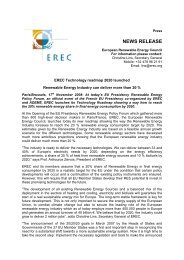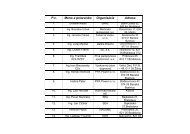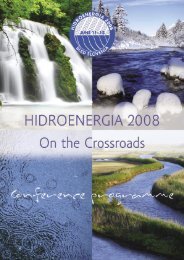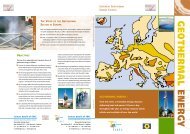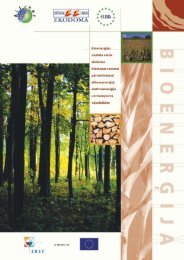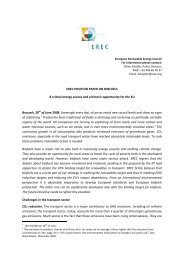Geothermal - European Renewable Energy Council
Geothermal - European Renewable Energy Council
Geothermal - European Renewable Energy Council
Create successful ePaper yourself
Turn your PDF publications into a flip-book with our unique Google optimized e-Paper software.
<strong>Geothermal</strong> Power<br />
Systems<br />
<strong>Geothermal</strong> power plant distribution<br />
Schematically, a geothermal system may<br />
be described as convective water in the<br />
Upper Earth crust, transferring heat, in<br />
a confined state, from a heat source to a heat<br />
sink (usually a free surface). Hence, a geothermal<br />
system includes three components, a heat<br />
source, a reservoir and a heat carrier fluid.<br />
8 %<br />
64 %<br />
28 %<br />
The heat source can be either a magmatic<br />
intrusion at very high temperature at relatively<br />
shallow depths (5 to 10 km) or simply, in case of<br />
low temperature systems, hot rocks at depth.<br />
Dry Steam<br />
Flash<br />
Binary<br />
Schematic representation<br />
of an ideal geothermal<br />
system.<br />
The reservoir consists of hot permeable rocks<br />
from which circulating fluids extract heat. The<br />
reservoir is generally overlain by impervious cap<br />
rocks and connected to a superficial outcropping<br />
area subject to meteoric recharge, which<br />
replaces, at least in part, the fluids abstracted<br />
through spring or/and well discharge as depicted<br />
in the attached sketch.<br />
The geothermal fluid is water, most often of<br />
meteoric origin, in either liquid or vapour phase<br />
depending on its temperature and pressure. The<br />
geothermal water often contains dissolved chemicals<br />
and gases such as CO 2<br />
, H 2<br />
S, etc…<br />
Hot water and steam are extracted by drilling<br />
wells into reservoir thus enabling to exploit this<br />
clean and sustainable resource. In this respect,<br />
a reliable expertise and engineering skills have<br />
been developed in order to achieve relevant reservoir<br />
assessments and drilling locations. Once<br />
available at production well heads, geothermal<br />
fluids can be used for electric power generation<br />
or non-electric (direct uses) heating purposes<br />
or both (combined heat and power).<br />
Power plants need steam to generate electricity.<br />
The steam rotates a turbine that activates a<br />
generator (alternator), thus producing electricity.<br />
Conventional power plants burn fossil fuels to boil<br />
water. <strong>Geothermal</strong> power plants, instead, use steam<br />
produced from geothermal reservoirs, located at<br />
several hundred to a few thousand meters below<br />
ground. This steam production process does not<br />
requires any artificial nor natural combustion<br />
whatsoever, i.e. it avoids man-induced CO 2<br />
emissions. There are three types of geothermal<br />
power plants, dry steam, flash steam and binary<br />
cycle respectively.<br />
Largest installed capacities correspond to flash<br />
plants (64%) (see plant distribution diagramme);<br />
binary units, despite their presently low ranking<br />
(8%), due to smaller plant ratings, raise fast<br />
growing interest as they address widespread, low<br />
to medium temperature, resource settings.<br />
A total of ca 500 geothermal units were reported<br />
online in 2007. The maximum addresses about<br />
250 binary plants, totalling a 800 MW e<br />
installed<br />
capacity (i.e. a unit 3,3 MW e<br />
plant load). The sizes<br />
of flash and dry steam plants average 31 MW e<br />
and 44 MW e<br />
respectively.<br />
4 EGEC | <strong>Geothermal</strong> Electricity and Combined Heat & Power




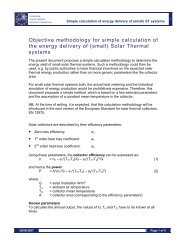

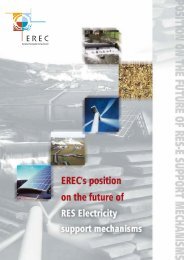

![Energy [R]evolution - Greenpeace](https://img.yumpu.com/47174859/1/184x260/energy-revolution-greenpeace.jpg?quality=85)
